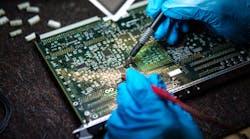Arm designed the blueprints for more than 100 billion chips installed in everything from smartphones and thermostats to industrial sensors and touchscreens in cars. But since its $32 billion acquisition by Softbank, the company has been pushing to develop chips that can connect a trillion devices over the next two decades. The challenges it faces are related to more than hardware.
Many companies are having trouble sorting through reams of data to make their operations more efficient. Others could tire themselves out sorting through all the different technologies used in factories, buildings and cities. Unless things change, companies may pull back on investments in the Internet of Things, which would cut into sales of Arm-based microcontrollers and other chips.
Under chief executive Simon Segars, Arm is taking matters into its own hands. The company is building software that can connect any number of devices regardless of how they are connected, what type of processor they have, what type of data they produce, or where the data is located. The software could lower what it costs to automatically connect and update millions and potentially billions of devices.
The company’s plans were underscored last week with its acquisition of Treasure Data, which develops data management tools for businesses. The Mountain View, California-based company can combine raw data from Internet of Things devices like sensors installed in store shelves, wind turbines or factory floors so that it can be analyzed. Arm’s chief marketing officer Joyce Kim declined to comment on the terms of the deal.
The deal dovetails with Arm’s other software investment. In June, the acquisition of Stream Technologies gave it software that reduces the costs and inconveniences of establishing connectivity. Before that, the company acquired Simulity to expand into hardware that can confirm whether an electronic device is allowed to access a certain wireless network and software that can alter the device’s credentials remotely.
Arm said that it would continue to support customers of Treasure Data, which has raised $54 million in funding since it was founded in 2011. But the company also plans to combine Treasure Data with its other software over the next year. That includes Stream Technologies and Arm Mbed, which allows users to manage and update devices over the cloud. Customers will pay a monthly fee for the service.
The new service, which will be called Pelion, shows how seriously technology companies are trying to lower the bar for Internet of Things development. Google and Microsoft have pushed into device management to win over new cloud customers. Other companies like General Electric and Honeywell have focused on harnessing the wealth of data collected from industries like healthcare or manufacturing.
What makes the new service different, according to Dipesh Patel, president of Arm’s Internet of Things services group, is that “it is a truly horizontal platform capable of managing any number or type of devices and connectivity, dealing with any type of data and linking to any cloud.” He added on a conference call about the deal: “You can get a single unified view of your devices and data.”
The service gives companies another way to combat security threats, which could also inhibit the Internet of Things. With Pelion, companies can remotely patch everything from factory sensors to traffic lights as vulnerabilities arise. Manually updating billions of chips that may not be replaced for decades would be too costly and impractical. Arm’s chief executive has said that managing security is more realistic than solving it.
With Pelion, companies are able to automatically onboard and provision devices deployed on private data centers or over the cloud, Patel said. It also manages connectivity based on any wireless standard used in any geographic location. Treasure Data gives customers the ability to take advantage of data from any number of devices. “The biggest theme we are seeing in the IoT is complexity,” said Patel. “It needs to be made simple,” he said.
